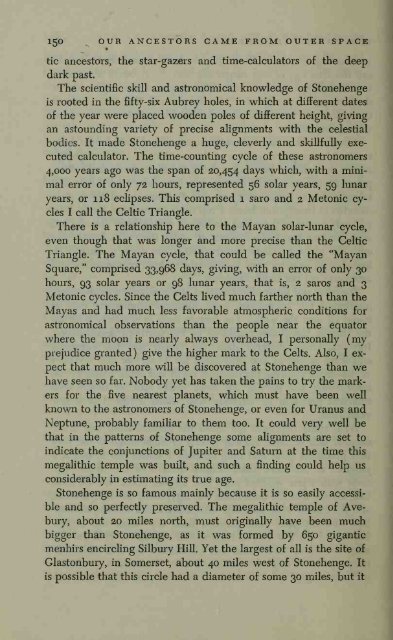Create successful ePaper yourself
Turn your PDF publications into a flip-book with our unique Google optimized e-Paper software.
150 . OUR ANCESTORS CAME FROM OUTER SPACE<br />
tic ancestors, the star-gazers and time-calculators of the deep<br />
dark past.<br />
The scientific skill and astronomical knowledge of Stonehenge<br />
is rooted in the fifty-six Aubrey holes, in which at different dates<br />
of the year were placed wooden poles of different height, giving<br />
an astounding variety of precise alignments with the celestial<br />
bodies. It made Stonehenge a huge, cleverly and skillfully executed<br />
calculator. The time-counting cycle of these astronomers<br />
4,000 years ago was the span of 20,454 days which, with a minimal<br />
error of only 72 hours, represented 56 solar years, 59 lunar<br />
years, or 118 eclipses. This comprised 1<br />
saro and 2 Metonic cycles<br />
I call the Celtic Triangle.<br />
There is a relationship here to the Mayan solar-lunar cycle,<br />
even though that was longer and more precise than the Celtic<br />
Triangle. The Mayan cycle, that could be called the "Mayan<br />
Square," comprised 33,968 days, giving, with an error of only 30<br />
hours, 93 solar years or 98 lunar years, that is, 2 saros and 3<br />
Metonic cycles. Since the Celts lived much farther north than the<br />
Mayas and had much less favorable atmospheric conditions for<br />
astronomical observations than the people near the equator<br />
where the moon is nearly always overhead, I personally (my<br />
prejudice granted) give the higher mark to the Celts. Also, I expect<br />
that much more will be discovered at Stonehenge than we<br />
have seen so far. Nobody yet has taken the pains to try the markers<br />
for the five nearest planets, which must have been well<br />
knowm to the astronomers of Stonehenge, or even for Uranus and<br />
Neptune, probably familiar to them too. It could very well be<br />
that in the patterns of Stonehenge some alignments are set to<br />
indicate the conjunctions of Jupiter and Saturn at the time this<br />
megalithic temple was built,<br />
considerably in estimating its true age.<br />
and such a finding could help us<br />
Stonehenge is so famous mainly because it is so easily accessible<br />
and so perfectly preserved. The megalithic temple of Avebury,<br />
about 20 miles north, must originally have been much<br />
bigger than Stonehenge, as it was formed by 650 gigantic<br />
menhirs encircHng Silbury Hill. Yet the largest of all is the site of<br />
Glastonbury, in Somerset, about 40 miles west of Stonehenge. It<br />
is possible that this circle had a diameter of some 30 miles, but it

















